A BRIGHT TOMORROW
Orangutan group grows and our 2026 calendar


A BRIGHT TOMORROW
Orangutan group grows and our 2026 calendar

December 19, 2025, through January 4, 2026*
WE’RE AGLOW WITH THE SPIRIT AND MAGIC OF THE
“Merry and bright” takes on a whole new meaning as the Zoo lights up the night with family-friendly entertainment, specialty sips and snacks, and amazing illuminated experiences. Come help us ring in the season!
Join us at Albert’s Restaurant to indulge in the magic of Jungle Bells with a delicious three-course meal. Savor the season with our curated wine pairings and holiday-themed cocktails.
Book online through OpenTable zoo.sandiegozoo.org/dining/alberts

*Visit zoo.sandiegozoo.org/jungle-bells for dates, times, and exceptions.
MEMBERS are invited to join us for a Jungle Bells preview on December 19


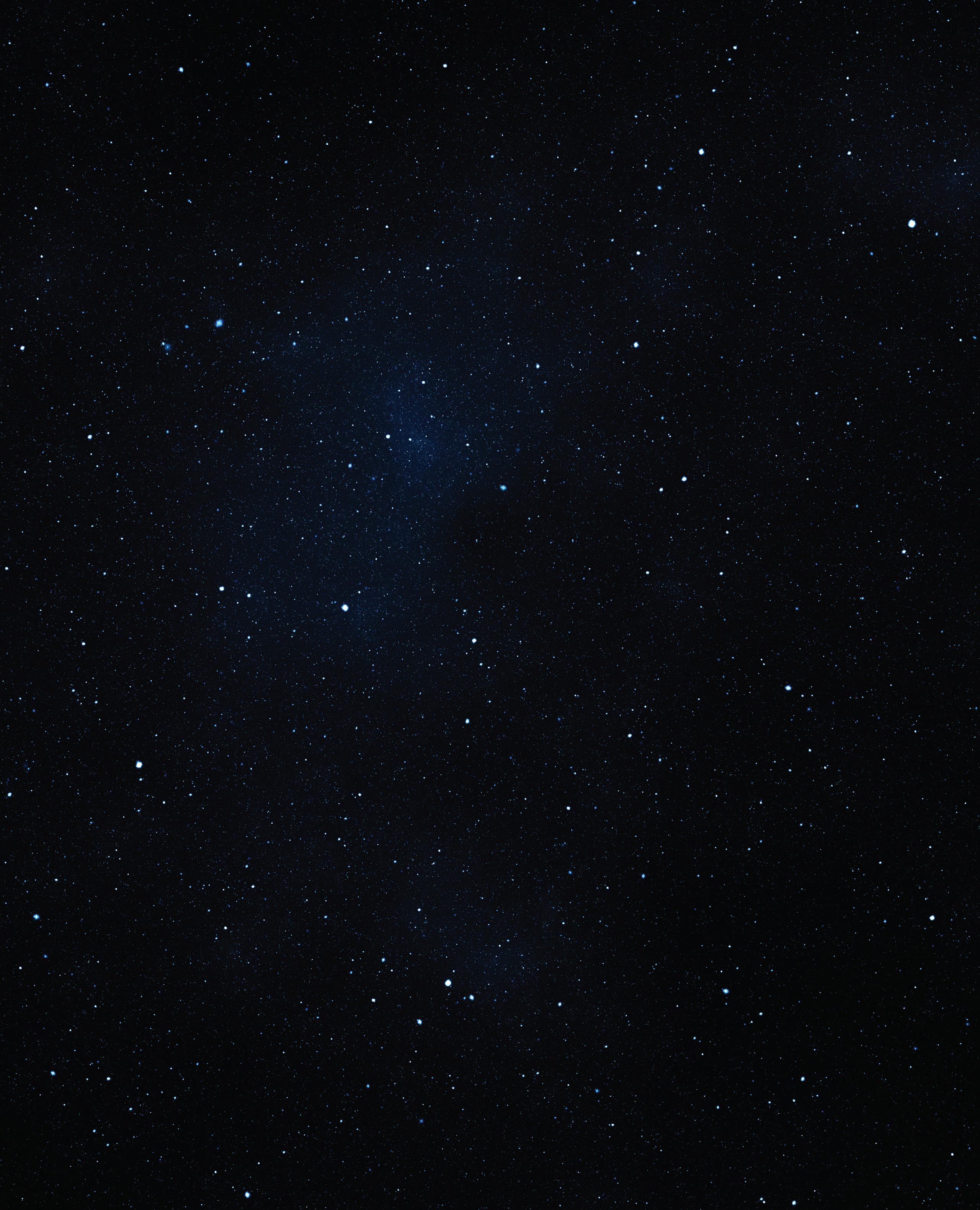



MANAGING EDITOR Peggy Scott STAFF WRITERS
Mike Hausberg
Aubrey Lloyd
Ellie McMillan
Elyan Shor, Ph.D.
DESIGNER Kaitlyn Lara PHOTOGRAPHERS
Ken Bohn
Tammy Spratt
DESIGN AND PRODUCTION
Lisa Bissi
Jennifer MacEwen PREPRESS AND PRINTING
Quad Graphics
Follow @sandiegozoo & @sdzsafaripark Share your #SanDiegoZoo & #SDZSafariPark memories on social media.
The Zoological Society of San Diego was founded in October 1916 by Harry M. Wegeforth, M.D., as a private, nonprofit corporation, which does business as San Diego Zoo Wildlife Alliance.
The printed San Diego Zoo Wildlife Alliance Journal (ISSN 2767-7680) (Vol. 5, No. 6) is published bimonthly, in January, March, May, July, September, and November. Publisher is San Diego Zoo Wildlife Alliance, located at 2920 Zoo Drive, San Diego, CA 92101-1646. Periodicals postage paid at San Diego, California, USA, and at additional mailing offices. POSTMASTER: Send address changes to San Diego Zoo Wildlife Alliance, PO Box 120271, San Diego, CA 92112-0271.
Copyright © 2025 San Diego Zoo Wildlife Alliance. All rights reserved. All column and program titles are trademarks of San Diego Zoo Wildlife Alliance.
The San Diego Zoo’s orangutan group has a new member, and 14-year-old Labu is forming important relationships as he begins this new chapter of his life.
As you can see on the pages of our 2026 calendar, our conservation work includes species great and small, from the African elephant to the Lord Howe Island stick insect, and every size in between. Explore the connection they have to the world around us all. 44
There’s a time for everything with species likes grizzly bears, Pacific salmon, and even trees in the forest. Explore how wildlife and ecosystems are linked in a cycle of interconnected rhythms.
As part of San Diego Zoo Wildlife Alliance’s commitment to conservation, This product is made of material from wellmanaged FSC ® -certified forests, recycled materials, and other controlled sources, chlorine free, and is Forest Stewardship Council® (FSC ®) (COC) certified. FSC ® is not responsible for any calculations on saving resources by choosing this paper.
If your mailing address has changed: Please contact the Membership Department by mail at PO Box 120271, San Diego, CA 92112, or by phone at (619) 231-0251 or 1-877-3MEMBER
For information about becoming a member of San Diego Zoo Wildlife Alliance, please visit our website at ZooMember.org for a complete list of membership levels, offers, and benefits.
Paid subscriptions to San Diego Zoo Wildlife Alliance Journal are available. Contact the Membership Department for subscription information.


November has always felt like a season of change. In nature, every transformation opens the door to renewal, and at San Diego Zoo Wildlife Alliance, these moments remind us of our purpose. In this issue of the Journal, we are celebrating “A Bright Future.” The pages of our 2026 calendar (included inside) feature 12 species at the San Diego Zoo and Safari Park, highlighting their uplifting, unique stories and the vital roles they play in our global conservation efforts.
At our core, the Alliance is driven by our vision of a world where all life thrives. Sometimes this means offering second chances or creating opportunities for deeper connections. For over 60 years, our teams and global partners have worked tirelessly to protect endangered Fiji iguanas. This mission continues with the arrival of a group rescued from illegal wildlife trafficking in Spain. Unable to return to their native habitats, they’ve now found a safe home at the San Diego Zoo, where expertise and compassion come together to ensure a promising future.
That same spirit of renewal is reflected in the orangutan group at the Zoo as their newest member, a young male named Labu, continues to deepen
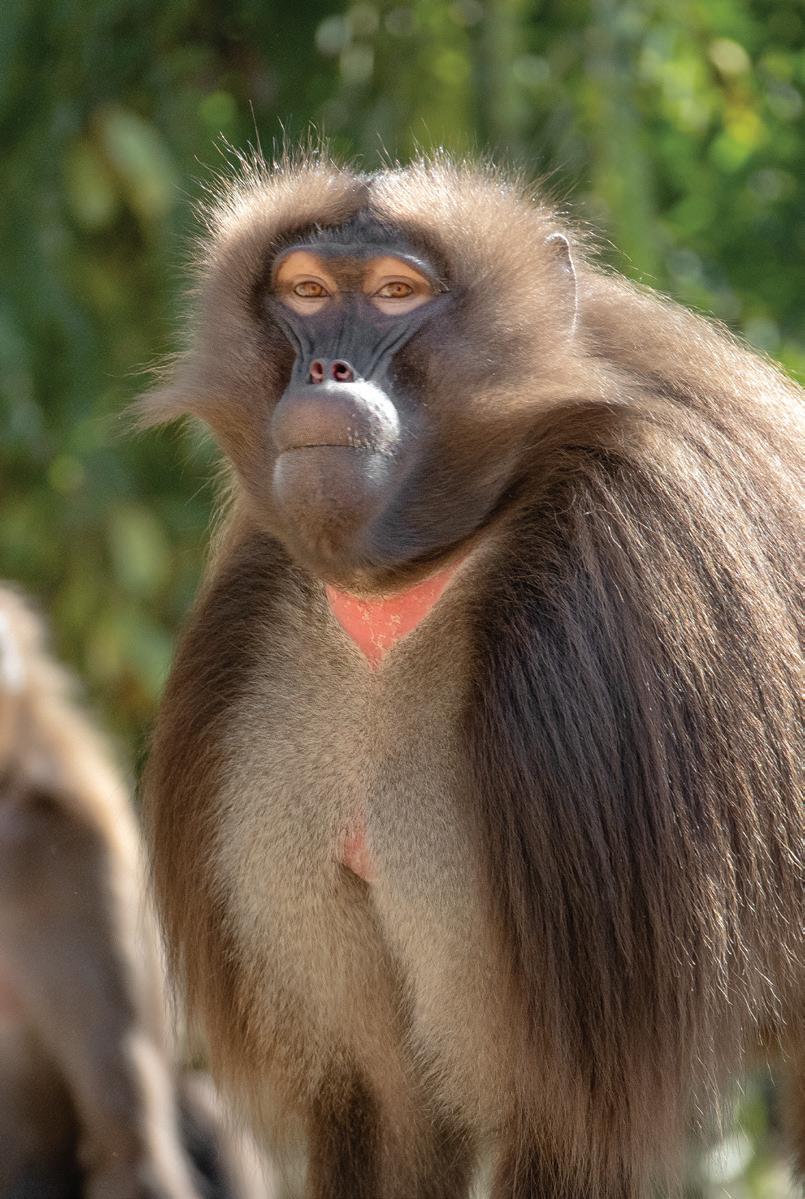
his bond with the others. His growing relationships with the other orangutans in the habitat, including the younger ones, demonstrate the complexity and nuances of their group dynamics.
Whether sparked by rescue, arrival, or resilience, every new beginning strengthens our shared journey.
Together with you, our Alliance continues to build a future filled with hope and connection.
Together for Wildlife,
Officers
Steven S. Simpson, Chair
Rolf Benirschke, Vice Chair
Adam Day, Treasurer
Gary E. Knell, Secretary
Trustees
Tom Chapman
E. Jane Finley
Clifford W. Hague
Bryan B. Min
Kenji Price
Corinne Verdery
‘Aulani Wilhelm
Trustees Emeriti
Javade Chaudhri
Berit N. Durler
Thompson Fetter
Richard B. Gulley
Robert B. Horsman
Steven G. Tappan
John M. Thornton
Executive Team
Shawn Dixon
Interim President and Chief Executive Officer
David Franco
Chief Financial Officer
Erika Kohler
Senior Vice President and Executive Director, San Diego Zoo
Pat McTigue
Interim Executive Director, San Diego Zoo Safari Park
Nadine Lamberski, DVM, DACZM, DECZM (ZHM)
Chief Conservation and Wildlife Health Officer
Wendy Bulger
Shawn Dixon Interim President and Chief Executive Officer
General Counsel
David Gillig
Chief Philanthropy Officer
Aida Rosa
Chief Human Resources Officer
David Miller
Chief Marketing Officer

Our conservation efforts begin with the work that happens every day at the San Diego Zoo and San Diego Zoo Safari Park and span the globe through our eight Conservation Hubs. Our collaborative successes are what make it possible to secure the future for vulnerable species. Here are a few highlights from 2025 that are carrying our efforts forward.
14 & 15
The giraffe tower welcomed the 14th and 15th Masai calves born at the Safari Park, boosting this endangered species’ global population.
100
We celebrated the birth of more than 190 joeys as well as a century of collaborative koala care and conservation at the Zoo.
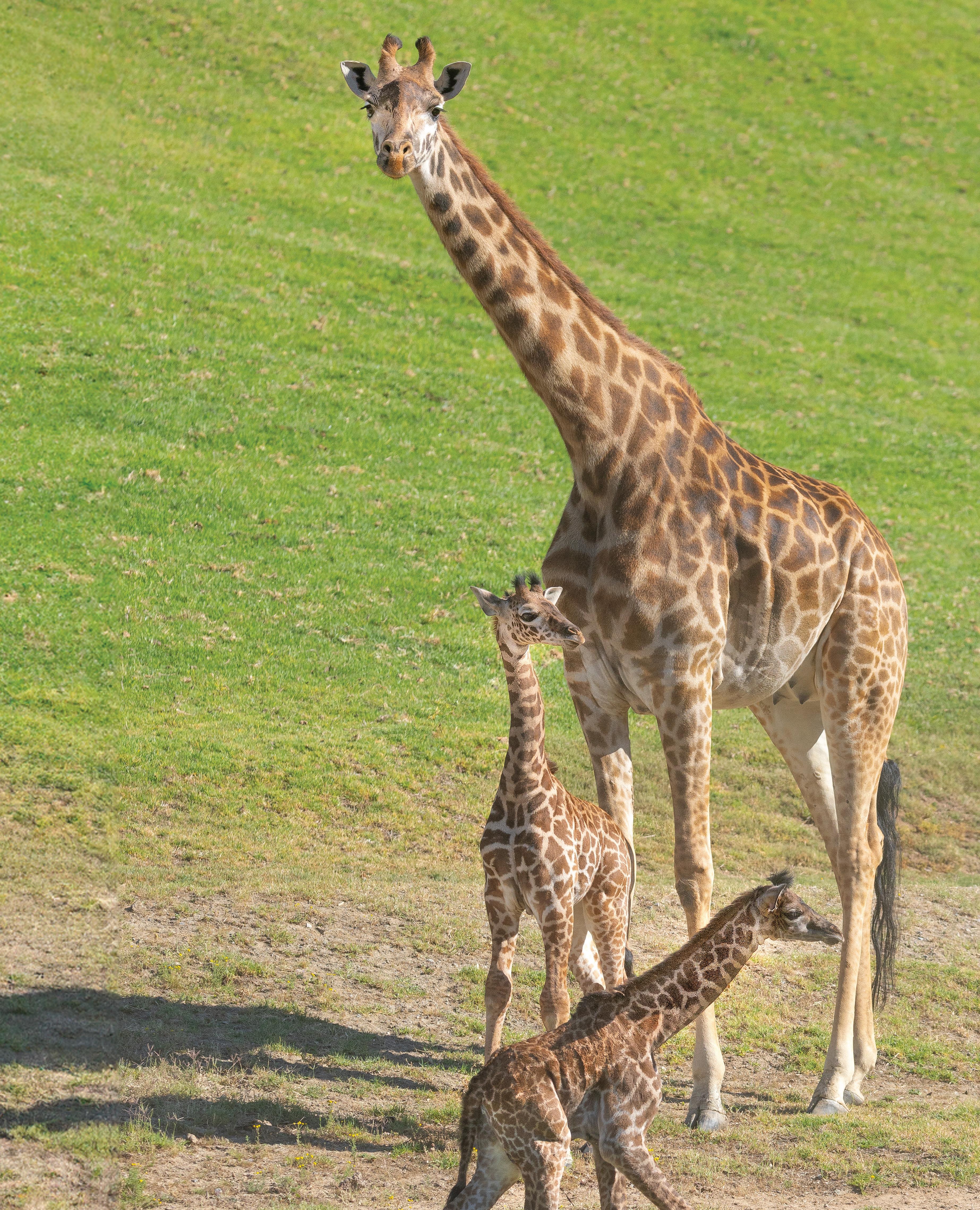
Eight Fiji iguanas are being cared for at the Zoo after being rescued from the illegal wildlife trade.
The Frozen Zoo® began as a bold vision 50 years ago and is now the most extensive biobank of its kind—and growing.
1
Opening in early 2026, the Safari Park’s Denny Sanford Elephant Valley is a one-of-a-kind place where you’ll connect with the herd like never before.



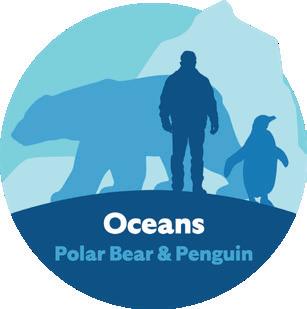




San Diego Zoo Wildlife Alliance protects and restores nature in eight Conservation Hubs on six continents. Below are recent discoveries and progress reports from around the world.

When a ghost mantis at the San Diego Zoo sustained a hernia (internal tissues protruding through her abdomen), our team preformed emergency surgery to treat her injury and save her life. Ghost mantis bodies resemble dead leaves, and they are only about two inches long and the approximate weight of a single penny, so the medical procedure required the use of microsurgical tools. Using a miniature probe and forceps, we replaced the tissues, covered them with a fat pad to prevent reherniation, and applied a protective medical paste to the site until her body wall sealed. After the procedure, we provided daily wound care and antibiotics. Insect medicine is still a developing field, so the lessons we learn and share from every case are vital to informing insect health worldwide.


For the first time, our team has successfully banked Nuttall’s scrub oak pollen in SDZWA’s Frozen Zoo. Endemic to California and Baja California (Mexico), the endangered Nuttall’s scrub oak is a keystone species, playing a vital role in maintaining ecosystem health and balance. But as an “exceptional species,” its acorns cannot be preserved through traditional seed banking methods. To address this challenge and safeguard genetic diversity in the face of increasing threats to these oaks, our team collected pollen from trees across San Diego County. A tailored protocol was developed to dry and cryopreserve (deep freeze) the pollen for long-term storage. This achievement builds on our prior biobanking efforts, including the cryopreservation of Nuttall’s scrub oak embryonic tissue in 2024. Together, these preserved materials provide a critical resource for future restoration efforts.
Our team and partners in Kenya recently completed a threemonth assessment of African leopard populations. Utilizing 150 trail cameras across nearly 1,000 square kilometers in central Kenya, this effort represents a significant step toward understanding the status of these big cats. Common survey methods, such as aerial and driving surveys, are ineffective for leopards due to their elusive nature. Our large-scale trail camera assessment will enable the inclusion of leopards in Kenya’s National Wildlife Census for the first time. The data we collected are being analyzed and will be incorporated into the 2024-2025 census, providing a foundation for a national leopard population estimate.
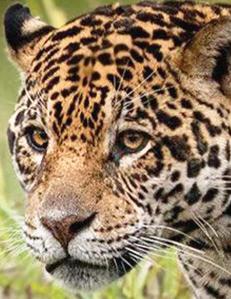

Explore breathtaking landscapes by boat, on foot, and by 4x4 with our Jaguars and Wildlife of Brazil’s Pantanal Adventure, June 2–12, 2026.

Experience the incredible wildlife of the Galápagos Islands aboard a luxury catamaran with just 16 guests, April 8–17 or December 2–11, 2026.

Immerse yourself in the rugged beauty of Lake Clark National Park on our Alaska Bear Camp Adventure, July 27–August 1, 2026.

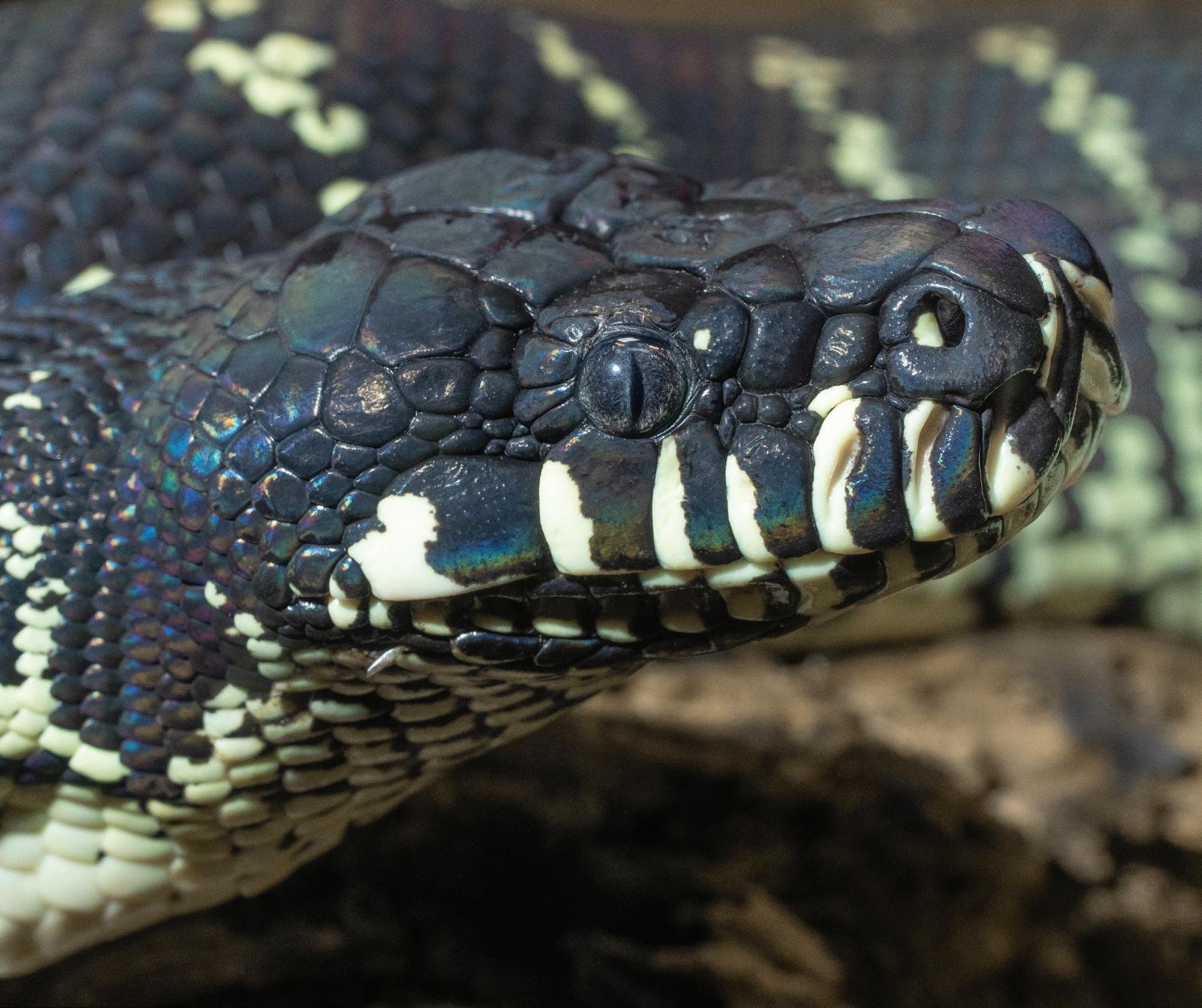


Wildlife Care Manager, Herpetology and Ichthyology San Diego Zoo
Brandon manages a dedicated team of wildlife care specialists who ensure every reptile, amphibian, and fish they care for thrive. He also collaborates with team members in departments throughout San Diego Zoo Wildlife Alliance and with our partners worldwide to support conservation, education, and best practices in wildlife management.
How did you first become interested in doing what you do?
Growing up, I wasn’t allowed to have a dog or cat, but when I brought my first frog home, my parents gave their approval. That moment sparked my passion for reptiles and amphibians. I spent a lot of time at the library, reading everything I could on these amazing animals.
What were your first experiences at the Zoo?
I had the unique privilege of growing up around the San Diego Zoo thanks to my aunt, who dedicated 31 years of her career here. Summers were always a highlight, as I attended Zoo camp and made great memories exploring wildlife and learning about conservation. Later, I had the opportunity to work at the Zoo, often carpooling with my aunt—a full-circle moment that deepened my connection to this remarkable place.
Who has inspired you along the way?
My uncle was a true outdoorsman who shared his deep respect and knowledge of wildlife with me, especially when it came to snakes. He taught me to appreciate and respect rattlesnakes, even though they can be dangerous, educating me on how crucial their role is in the ecosystem.
What is the most misunderstood species you work with?
Snakes. Many people fear or dislike them, but snakes don’t hate humans. They simply want to avoid us as much as possible. As we continue to share their habitats, it’s important to learn how to coexist with snakes. Understanding their role in the ecosystem can help replace fear with respect.
What is the most rewarding part of your job?
Witnessing first hand the incredible work that the Alliance has accomplished. A perfect example is our work with western pond turtles, a native species facing numerous challenges. We have been instrumental in restoring their populations through headstarting programs, where we care for them until they’re big enough to survive on their own. Watching these tiny hatchlings grow under our care, knowing they’ll one day return to their native habitats with a better chance of survival, is truly amazing.
How is your team making a difference?
The Herpetology and Ichthyology team does an amazing job ensuring wildlife we care for have everything they need to thrive. They carefully design habitats to encourage natural behaviors. Equally important is how they share their passion for reptiles and fish with our guests. Through presentations or engaging in conversations outside the reptile habitats, the team inspires a deeper appreciation for these incredible species, creating more allies for wildlife.

BY:
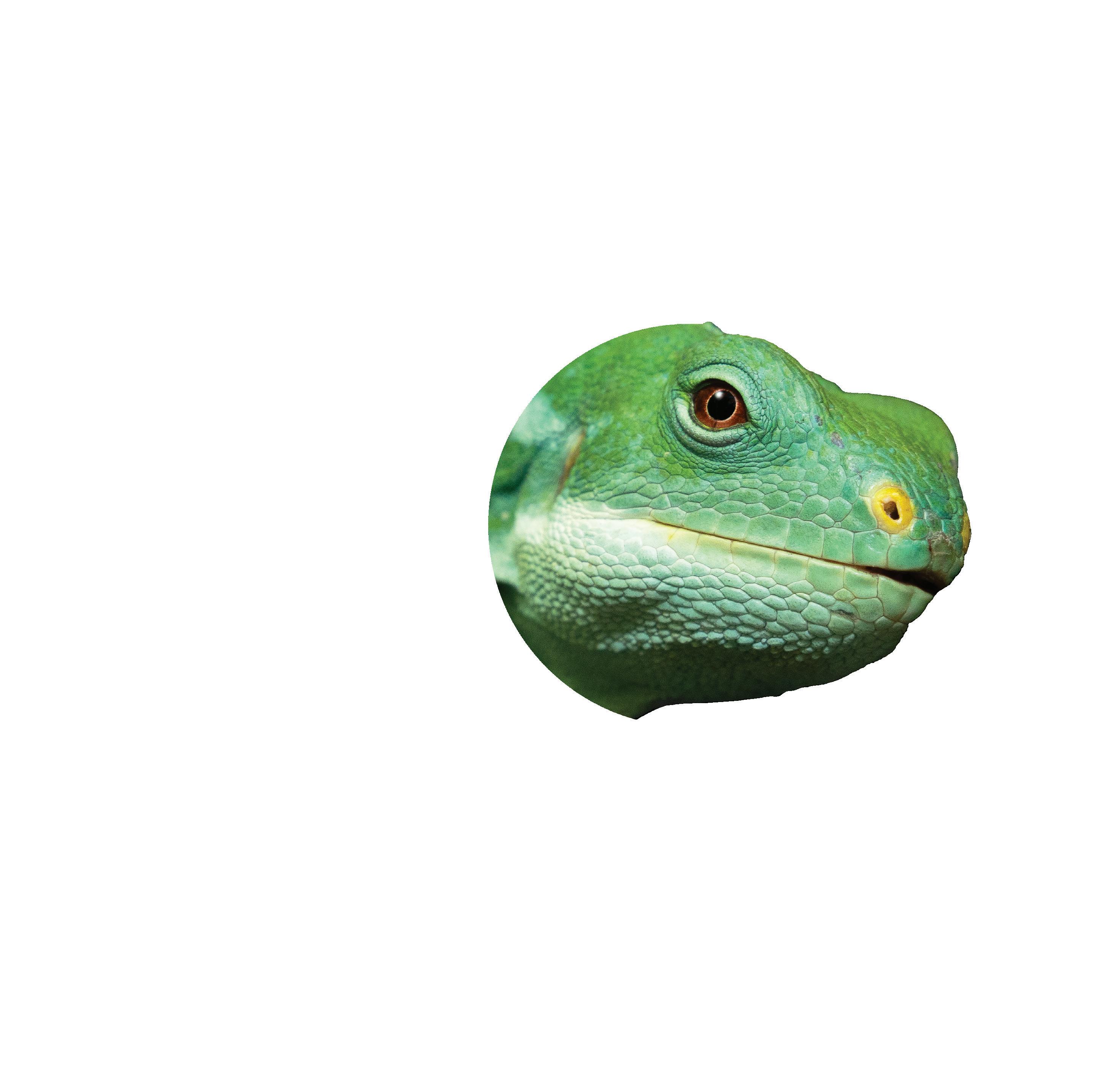



The iguanas received thorough medical exams that included ultrasounds, eye exams, blood draws, and x-rays.
Dr. Amanda Burkes checks the eyes of a Fiji banded iguana for signs of disease or abnormalities.
future for wildlife.
In 2017, more than 600 illegally trafficked reptiles were seized in a confiscation by Spanish authorities. A group of Fiji iguanas was part of the rescue, and discussions arose about the best course of action for them. Since little was known about their origins, they unfortunately couldn’t be returned to native habitats. Meanwhile, discussions took place between The CITES Management Aurthority of Spain, National Trust of Fiji, Department of National Heritage Fiji, NatureFiji-MareqetiViti and the San Diego Zoo. It was unanimously decided that the best place for these iguanas was at the San Diego Zoo with years of successfully housing and caring for this species.
Moving endangered wildlife halfway across the world requires meticulous planning and coordination between countless collaborators. When it was time, our teams jumped into action to ensure the iguanas’ health and safety throughout the long journey to California, accompanying them all the way from Spain. Upon arrival in San Diego, it was all hands on deck as our Wildlife Care, Wildlife Health, and Conservation Science teams came together to assess the iguanas. This multipronged approach included full health examinations to help ensure each individual had what they need to thrive.
One unique challenge in welcoming rescued wildlife is that often, little is known about their history and where they’re from.
With the help of our Conservation Genetics team, we’ll be able to answer some of these questions. Routine genetic testing can fill in the blanks on critical information we’d otherwise never be able to discover, such as the iguanas’ species, the group’s genetic diversity, and their potential islands of origin— including whether they were likely trafficked directly from their native habitats in Fiji or illegally bred. Every clue our experts uncover about the group’s mysterious past leads to increased understanding of both the individual and the species, helping conservationists equally in caring for them and securing a more sustainable future.
After their unique journey, this special group of Fiji iguanas is settling in at the Zoo. Their remarkable story is one of resilience, hope, and a fresh start—and it’s only just beginning. The iguanas’ rescue is a powerful reminder that when we come together with expertise, collaboration, and perseverance, we can achieve anything. With the help of wildlife allies like you, we’re making a difference for vulnerable and endangered species across the globe.
Discover the full story here:


A new member is a new beginning for the San Diego Zoo’s vibrant orangutan group.
BY SARA MAHER | PHOTOGRAPHY BY KEN BOHN
Experiencing a group of Sumatran orangutans at the San Diego Zoo is witnessing a world in constant motion. Little Kaja excitedly scrambles up a rope leading onto a towering climbing structure while his mother, Indah, looks on. Another of Indah’s offspring, Aisha, watches contentedly from a sunny spot on a soft patch of grass.
Karen uses a stick to investigate the many holes in a faux termite mound, then moves over to a rock formation and drinks from a pool of water. Observing all of this is the group’s newest member, Labu. His arrival marks a new beginning, both in his personal journey as a maturing male orangutan and for the group that welcomed him.


Watching this vibrant community, it wouldn’t be obvious that orangutans are considered the only semi-solitary apes. But for a long time, this was the case. Orangutans were observed over large areas in their native forest habitats on the islands of Sumatra and Borneo, and while they interacted with other orangutans while moving throughout the trees, they did not form tight social groups.
However, recent studies indicate this isolation was simply a necessity for survival. Because orangutans mostly eat ripe fruits they find scattered across the forest floor, they have to spread out to find sufficient resources and ensure all have enough to eat. When food is
plentiful, they are more social. Unfortunately, their native habitat is threatened by deforestation, mainly driven by the clearing of land for unsustainable palm oil plantations. This decreases the support available for orangutans and makes it difficult for them to come together in groups. Orangutans at the Zoo experience abundant resources throughout their expansive and multidimensional ecosystem. Just as they would in native habitats, they choose how they want to engage with the space— and with each other. And when their survival is not at risk, it turns out orangutans aren’t so solitary after all. They form intimate bonds based on respect, communication, and their own special type of family.


Coming together:
When 14-year-old Labu was welcomed into the Zoo group, he was a bit hesitant. As a young adult male, he hadn’t spent time outside of his family group. This was his opportunity to venture out on his own and start again as a self-sufficient orangutan.
Naturally, Labu approached the group with caution and deference. An older and more social female, Karen, was the first to welcome him. Karen was friendly with her new companion, and Labu quickly connected with her, looking to her for guidance during his first few weeks. Because orangutans generally don’t form large social groups, they don’t default to hierarchical or gender-based
relationships; they choose who they want to interact with, and in what way. “While Labu is the largest and strongest member of the group, he’s been closely following Karen’s lead on how to get the most from daily orangutan life in his new home,” says Heather Myers, wildlife care supervisor, primates. Karen showed Labu their complex habitat and taught him how to engage with the many diverse resources they could discover there. Labu’s bond with Karen gave him confidence and made him comfortable enough to not force interactions with more cautious orangutans, like Aisha. Instead, their bond could evolve slowly and organically.

“Orangutans form intimate bonds based on respect, communication, and their own special type of family.”
Confident and friendly Karen (right) was the first to welcome Labu (left) to the group.

Aisha was very interested in Labu when he first arrived, but wasn’t sure how to approach him. The two are in similar life stages, but Aisha did not have much experience with males, especially ones close to her own age. She wasn’t fond of Labu approaching her first, and she let him know. Orangutans are incredible communicators and set firm boundaries with each other regarding different aspects of group life. According to Tanya Howard, senior wildlife care specialist, primates, “They are so subtle they could be having full conversations and we wouldn’t know it.” Labu showed understanding for his more reserved companion and allowed her to approach him from that point on. This gesture built trust and strengthened their connection. Now Aisha chooses to spend more time near Labu, and they even share a hammock occasionally. With this new relationship, Aisha is growing into a more self-confident young adult.
Indah, the oldest, was a bit more wary of the newcomer. Her son, three-year-old Kaja, was the youngest in the group, and her top priority was keeping him safe. Orangutans are dependent on their mothers for about eight years, much longer than most other species, and the bond between mother and young is very strong. When Labu first arrived, the normally rambunctious Kaja paid attention to his mother’s cues and stayed close to her. But his curiosity soon got the best of him, and he started watching Labu interact with the females. “Kaja is going to mature a lot with another male present,” says Tanya. Even from a distance, Kaja can learn appropriate ways adults interact
“Orangutans are incredible communicators and set firm boundaries with each other.”
Seeing a calm role model like Labu will help spirited Kaja (top, with Karen) as he grows up.
with each other, how to set boundaries, and how to properly engage with females— opportunities he wouldn’t have without the abundant resources available at the Zoo, as male orangutans do not interact with little ones in less plentiful environments. Having a role model like Labu makes it much more likely that Kaja will grow into an easy-going and respectful orangutan himself. “[Labu is] a dream male,” adds Tanya. “Textbook, this is how you want a male to behave. It’s been a phenomenal experience.”
As Labu continues developing relationships, his confidence grows. He has gone from a shy young male to a lively and charismatic member of the group. His journey to find his place is one anyone can relate to as they navigate the world seeking a sense of belonging. This is one of the many reasons Heather has heard guests say the orangutan habitat is the first place they come when they visit the San Diego Zoo. “People really feel like they can make a connection to them,” she says, just as the orangutans are making connections with each other.
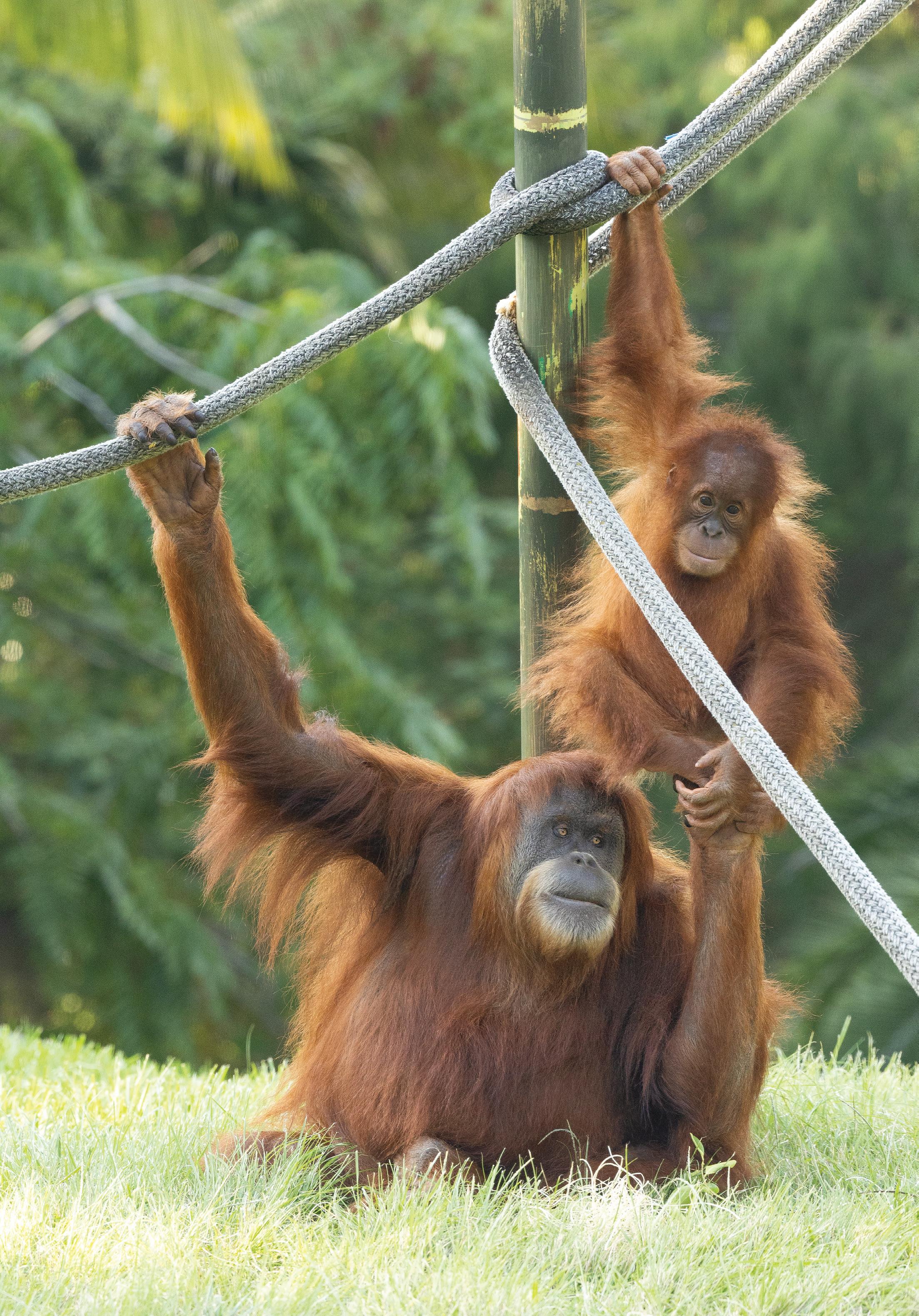
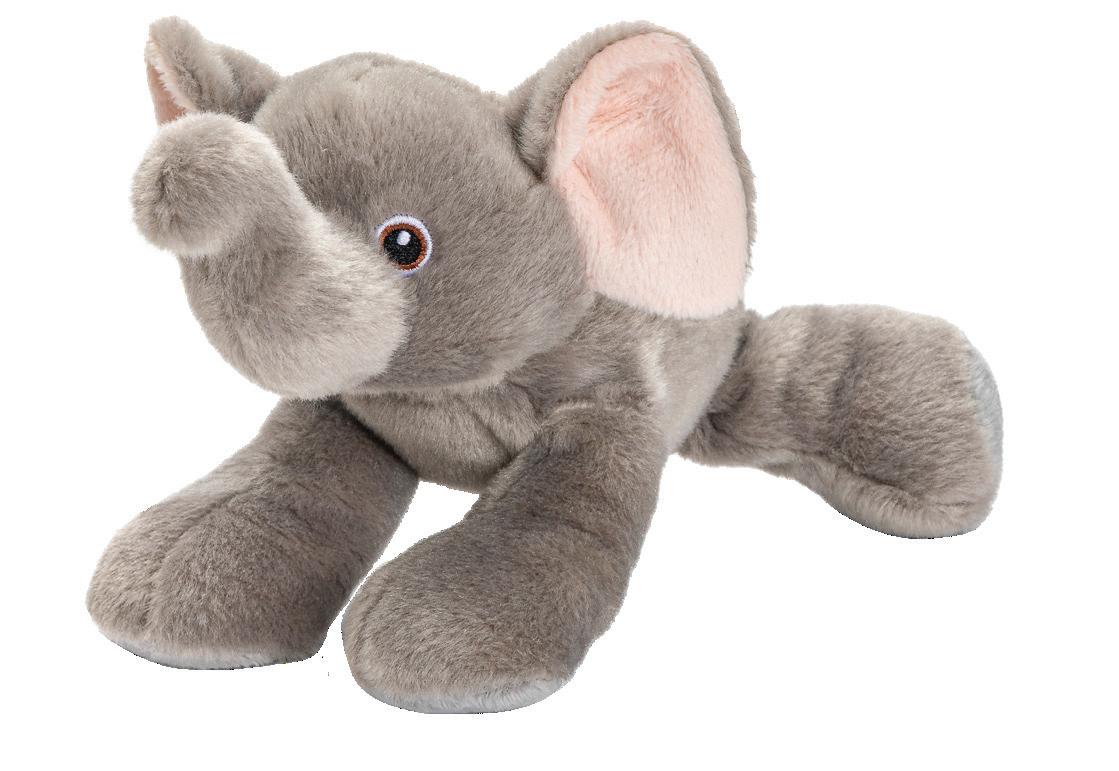
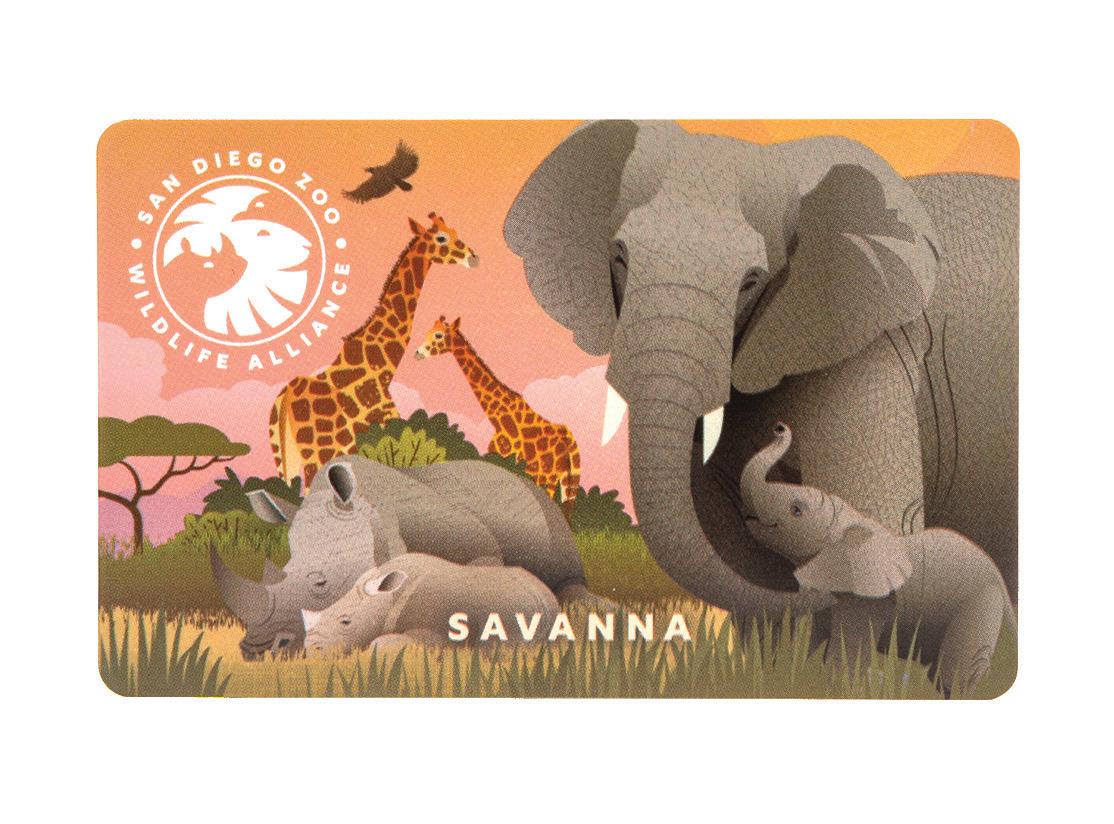






Visit sandiegozoo.org or call 619-718-3000 to
*Gift cards can be used toward any purchases at the San Diego Zoo or Safari Park (not available for online purchases). Discounts do not apply toward gift card purchases. Gift card and free plush will be shipped to any domestic street address you specify (shipping and handling charges apply). Plush may vary. Offer can be redeemed online at sandiegozoo.org or through Call Center purchases only. Not available on grounds at the San Diego Zoo, Safari Park, or shopzoo.com. Offer valid through January 4, 2026, while supplies last.





BY PEGGY SCOTT PHOTOGRAPHY BY KEN BOHN AND TAMMY SPRATT
If there’s one thing conservation organizations like San Diego Zoo Wildlife Alliance believe in, it’s the idea that if we all work together we can create a world where all life thrives. For challenges such as habitat loss and population instability there is not only optimism for the future, there are also collaborative projects to find solutions. And one crucial component of conservation involves creating meaningful connections between people and the wildlife with which we share the planet. At the San Diego Zoo and San Diego Zoo Safari Park, we are honored to care for some of the most amazing wildlife in the world. The species you see here—mammals, birds, reptiles, arthropods, amphibians, and plants—are living examples of the conservation work and successes you make possible around the globe. Each visit is a reminder that not only does wildlife need our help, we need wildlife to help make life on Earth complete. Every ecosystem needs all of its components in order to stay healthy and well balanced.
As you will see in our 2026 calendar, our conservation work includes species great and small, from the African elephant to the Lord Howe Island stick insect, and every size in between.
There are horticultural wonders and astonishing reptiles. And these species all have one thing in common: conservation offers hope and a brighter future for them, as well as the futures of their ecosystems. Every species has a role to play in its native range. Birds like the palm cockatoo help with seed dispersal. Its carrion-loving cousin, the vulture, is nature’s clean-up crew and prevents the spread of diseases like anthrax. The pronghorn, like other grazers, maintain the crucial balance of flora in their ecosystems. Mighty predators such as Amur leopards keep herbivore populations under control, which prevents overgrazing and maintains the health of the forest and its biodiversity.
Since 1916, the Alliance has worked to create enduring connections between people, wildlife, and the ecosystems we all share—and more than 100 years later, our commitment to that mission is stronger than ever. We believe that a strong connection to nature is fundamental to saving the world’s wildlife; and we seek to promote empathy and inspire people in ways that will cultivate a shared appreciation for nature and urge individual action on behalf of wildlife. For all of us. For a hopeful and brighter future for generations to come.



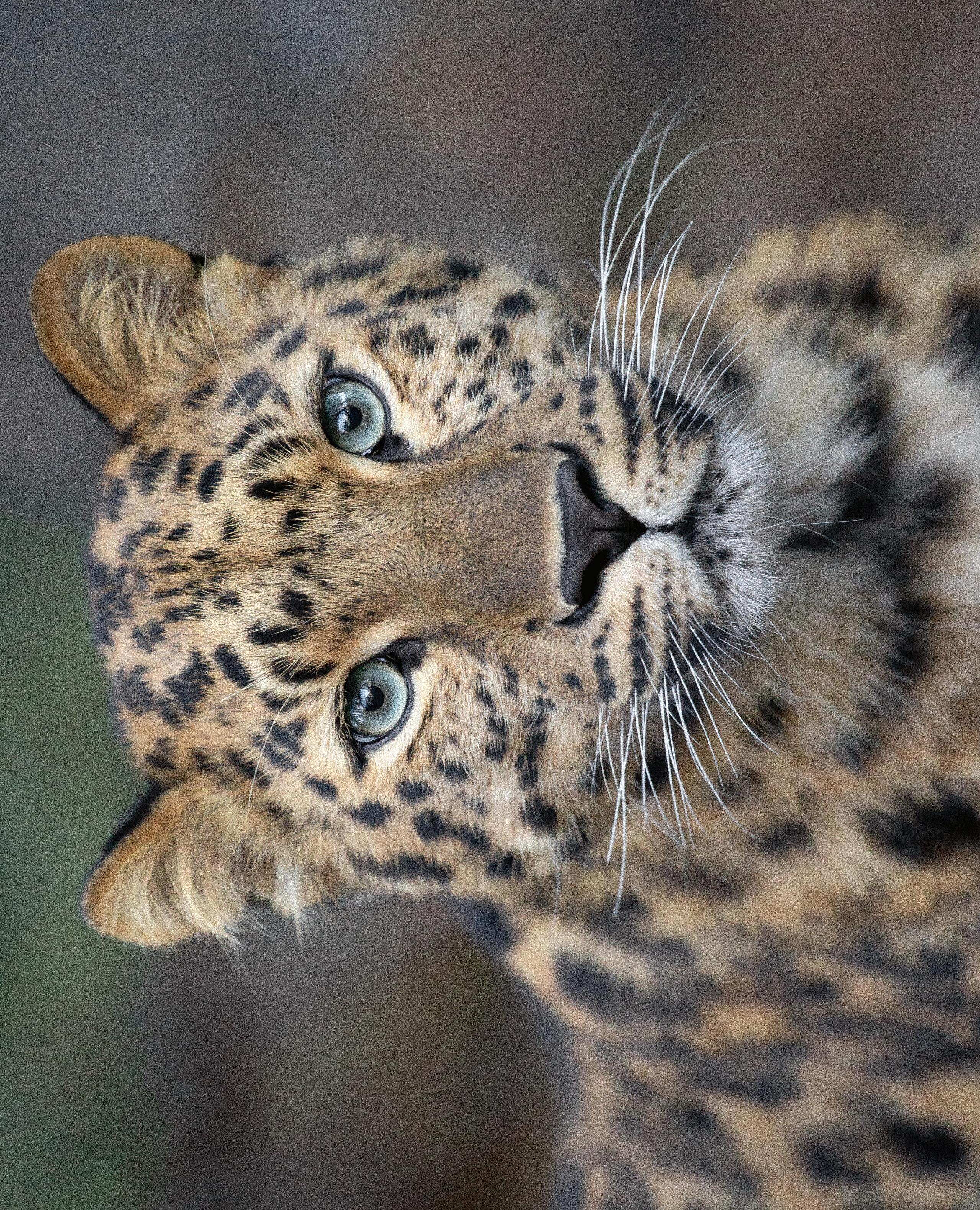

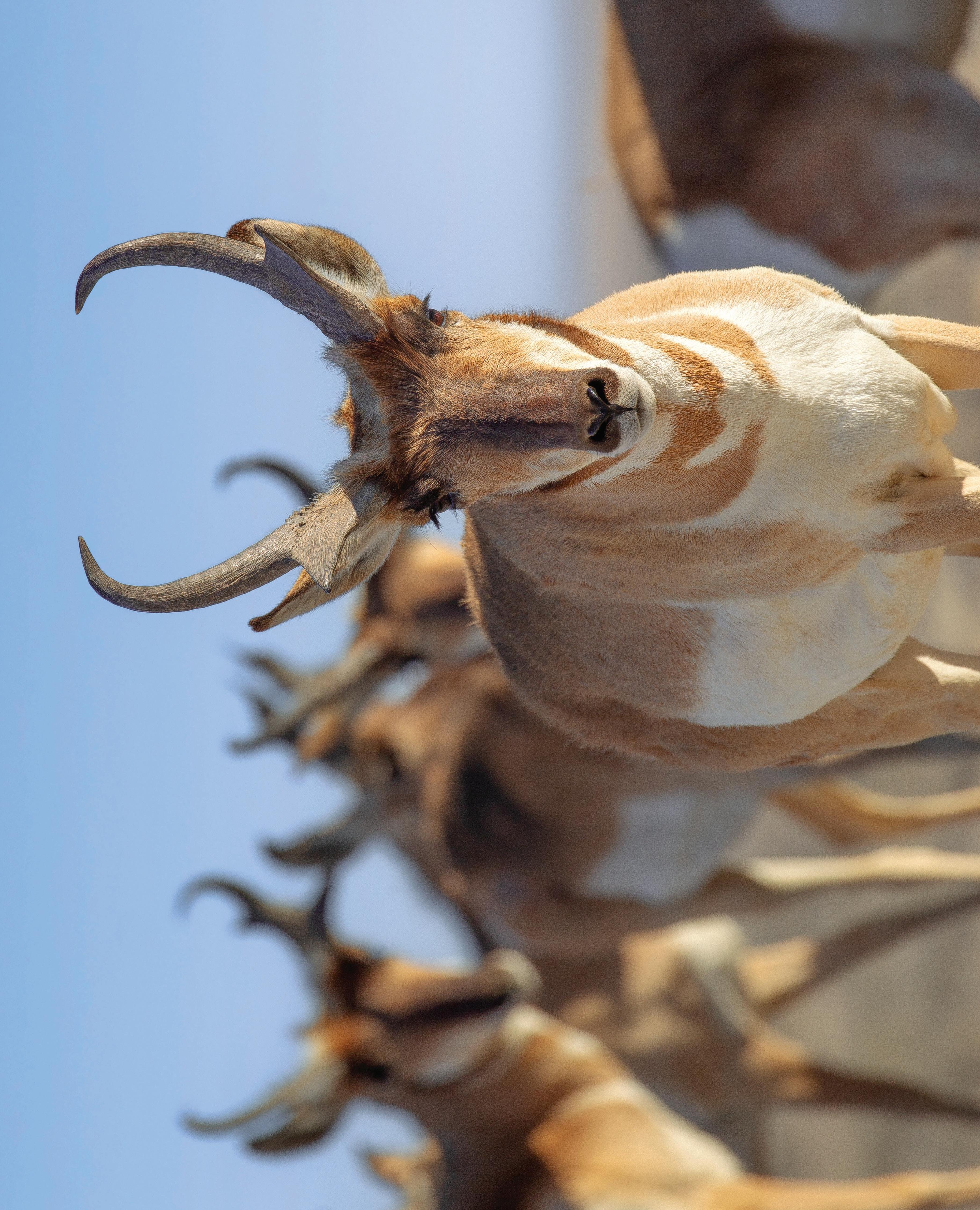


giant pandas Xin Bao and Yun Chuan made their public debut at
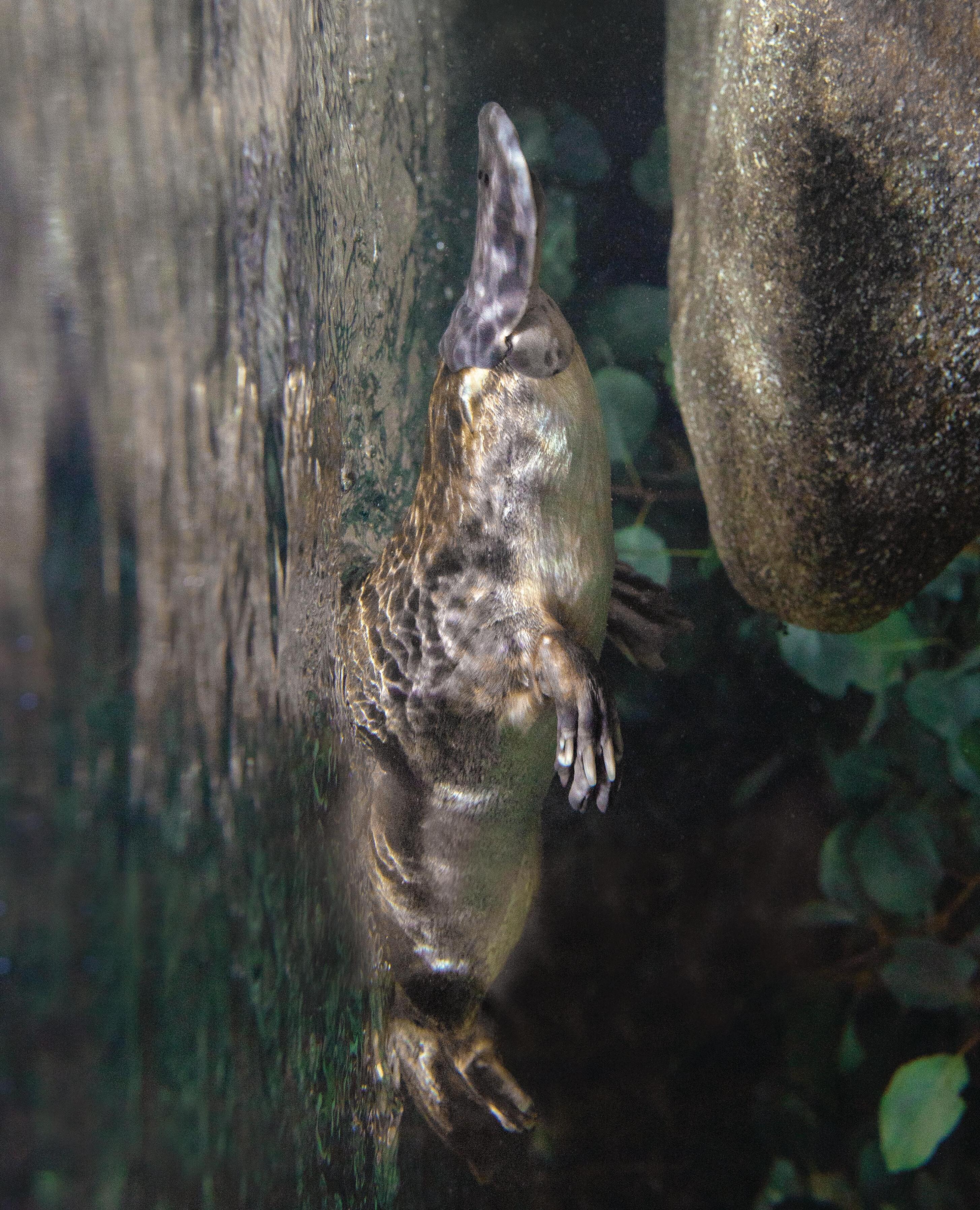
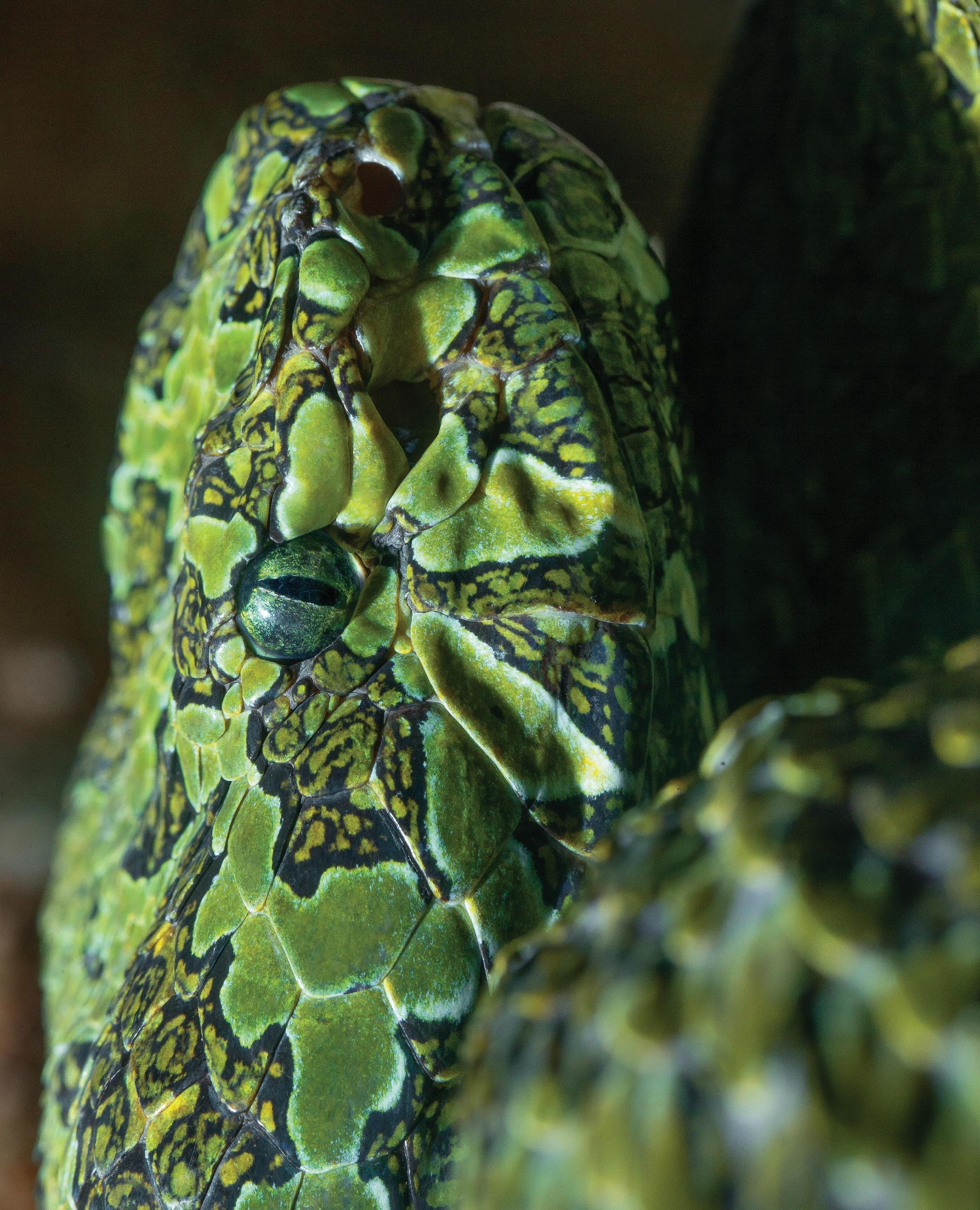
HalGLOWeen (Zoo) HalGLOWeen Member Preview (Zoo)
HalGLOWeen (Zoo) Autumn Festival (Park) New Moon 0
HalGLOWeen (Zoo) Autumn Festival (Park)
HalGLOWeen (Zoo)
HalGLOWeen (Zoo) Plant Day (Zoo) Kids Free Month begins (Zoo) Kids Free Month begins (Park)
HalGLOWeen (Zoo) Autumn Festival (Park) World Kangaroo Day (Park)
HalGLOWeen (Zoo)
HalGLOWeen (Zoo) Kids Free Month ends (Zoo) Autumn Festival (Park) Kids Free Month ends (Park) Halloween
HalGLOWeen (Zoo)
(Zoo)

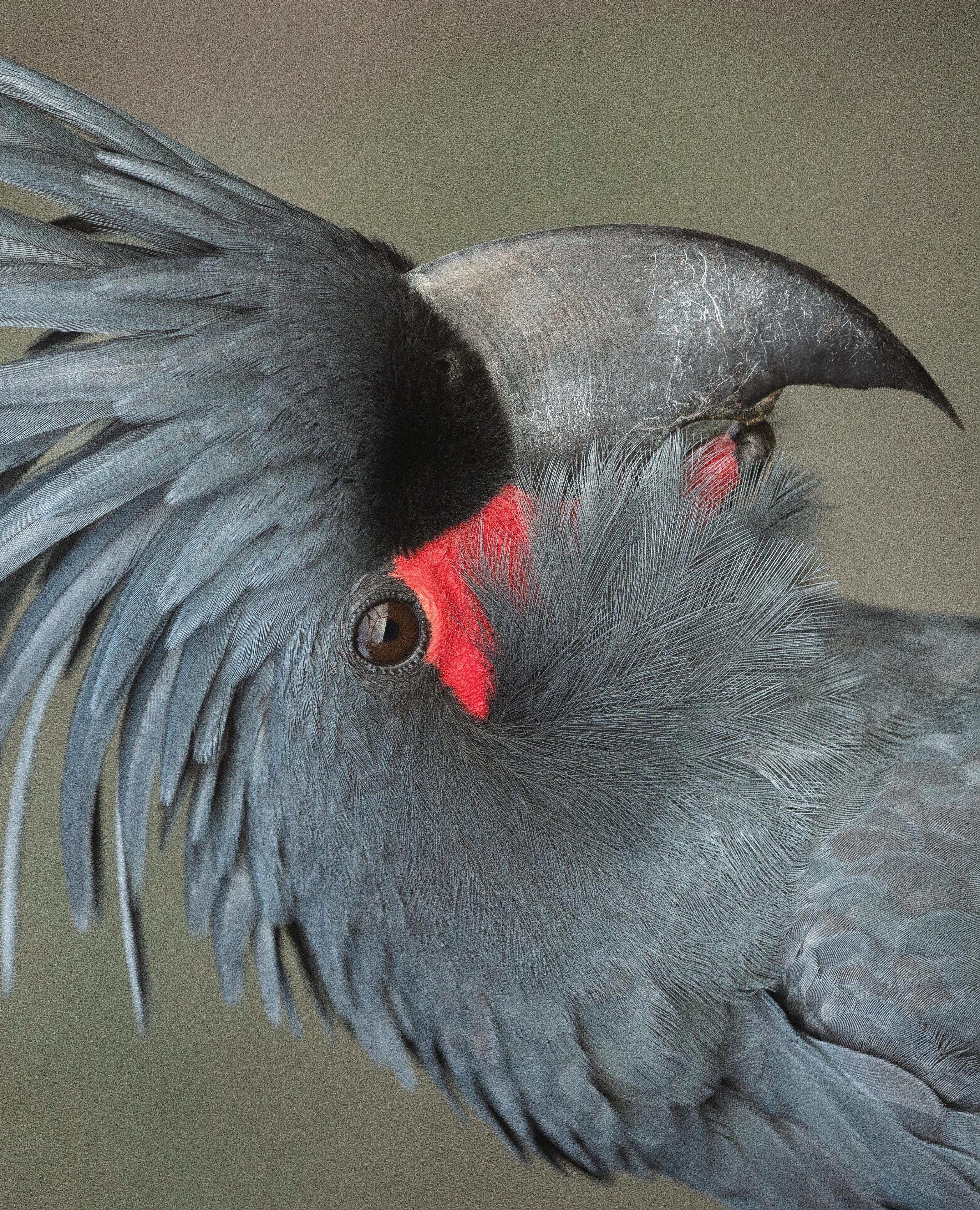
(Zoo)
Jungle Bells (Zoo) Wild Holidays (Park)
Jungle Bells (Zoo) Wild Holidays (Park) Kwanzaa begins
Jungle Bells (Zoo) Wild Holidays (Park)
Jungle Bells (Zoo) Christmas Day
Jungle Bells (Zoo) Wild Holidays (Park) Full Moon @
Jungle Bells (Zoo) Wild Holidays (Park)
Jungle Bells (Zoo) Wild Holidays (Park) Winter Solstice
Jungle Bells (Zoo) Wild Holidays (Park)
Jungle Bells (Zoo) Wild Holidays (Park)
Jungle Bells (Zoo) Wild Holidays (Park) New Year’s Eve
Jungle Bells (Zoo) Wild Holidays (Park) Last Quarter Moon T
Jungle Bells (Zoo) Wild Holidays (Park)
Jungle Bells (Zoo) Wild Holidays (Park)
Jungle Bells (Zoo) Wild Holidays (Park)
Jungle Bells (Zoo) Wild Holidays (Park)
The endangered palm cockatoo plays a critical role as a seed disperser, contributing to the health and diversity of the forests they inhabit across Australia and New Guinea. In a boost for its population, wildlife care specialists at the San Diego Zoo and Safari Park teamed up to foster and parent-rear a palm cockatoo chick last year at the Zoo.
BY ELYAN SHOR, PH.D. ILLUSTRATION BY AMY BLANDFORD
Wildlife around the world are linked in a network of interconnected rhythms — and like all good rhythms, timing is everything. These natural cycles of behavior and physiology are synchronized with each other and with environmental conditions, occurring at just the right place and time. This cadence maintains the function and balance of our ecosystems. Pictured here are some of the most iconic interconnected rhythms on Earth, recurring annually in North America’s Pacific temperate rainforests.
Grizzly Bears
Pacific Salmon
Forests
Insects
Insects emerge after a winter of dormancy. They feed on nectar and serve as pollinators as they move between flowers.
The forest undergoes rapid growth as plants uptake nutrients derived from salmon carcasses. Research shows that “salmon-fed” forests grow more than three times faster than salmon-less counterparts.
Grizzly bears exit their dens. To regain energy, they forage for grasses and roots and opportunistically hunt or scavenge.
Juvenile Pacific salmon migrate away from their natal stream. They will spend months to years feeding and growing in the open ocean.
During hyperphagia, a period of extreme overeating, bears gorge themselves on salmon, consuming tens of thousands of calories daily and gaining hundreds of pounds by fall.
Forest plants produce sugary berries, an important part of grizzly bears’ weight-maximizing diet. Bears drop salmon carcasses in the forest, and these carcasses fertilize the soil as they decompose.
In diapause, insects lower their metabolism and suspend development to conserve energy and endure the winter cold.
Grizzly bears enter their dens and go into torpor, a state of deep sleep and reduced metabolism. They survive off their stored fat reserves.
Pregnant females give birth in the den.
Adult salmon ready to spawn migrate from the ocean back to their natal stream, using their final energy to reproduce before dying.
Streams enriched by nutrients from salmon carcasses form the foundation of the food chain, supporting the hatching and growth of aquatic insects.
Plant growth slows or stops. Nutrients like nitrogen and phosphorous from salmon carcasses trickle into deeper layers of soil.
Salmon eggs incubate and hatch. The fish overwinter in the stream, consuming aquatic insect larvae as they develop into juveniles.
SELECT DATES IN DECEMBER 2025 AND JANUARY 1–4, 2026
The magic and spirit of the holiday season return! The Zoo lights up the night with amazing entertainment, featuring exciting seasonal attractions and experiences. Bring the family and enjoy some tasty treats and the warmth of the holidays. On December 19, San Diego Zoo Wildlife Alliance members are invited to enjoy a Jungle Bells Member Preview. (Z)

NOVEMBER 1–2
Wild Weekend: Oceans
Learn more about the wildlife of our Oceans Conservation Hub with special activities, wildlife care specialist talks, and more. (Z)
NOVEMBER 21 AND DECEMBER 19
Plant Day and Orchid Odyssey
On these special days, guests can take a rare look inside the Zoo’s Orchid House from 10 a.m. to 2 p.m., learn about the Zoo’s botanical collection on the Botanical Bus Tour at 11 a.m. and noon, and check out the Carnivorous Plant Greenhouse from 11 a.m. to 1 p.m. A variety of plants grown by Horticulture staff will be available at the Plant Sale, happening in front of the Orchid Greenhouse entrance from 10 a.m. to 2 p.m. (Z)
Wildlife Wonders
During Wildlife Wonders at the Zoo’s Wegeforth Bowl amphitheater, presented daily at 2 p.m., wildlife care specialists will introduce you to wildlife ambassadors representing San Diego Zoo Wildlife Alliance’s conservation work around the world. Learn about amazing wildlife—from the Amazon to right here in our own backyard in San Diego—and find out what everyone can do to help conserve wildlife and the world we all share. The presentation runs 15 to 20 minutes. (Z)
NOVEMBER 2 & DECEMBER 7
Member Exclusive Early Hours
Rise and shine with the sights and sounds of the San Diego Zoo. On select days, qualifying members* can enter the Zoo one hour before the general public. To join us, simply present your qualifying membership card at the main entrance beginning at 8 a.m. *Excludes memberships with blockout dates. (Z)
EVERY DAY
Wild PerksSM
San Diego Zoo Wildlife Alliance members are eligible for Wild PerksSM . Show your membership card each time you make a purchase and save up to 20%, depending on your membership level. Some exclusions apply; for details, visit sdzwa.org/ membership/wild-perks. (Z)
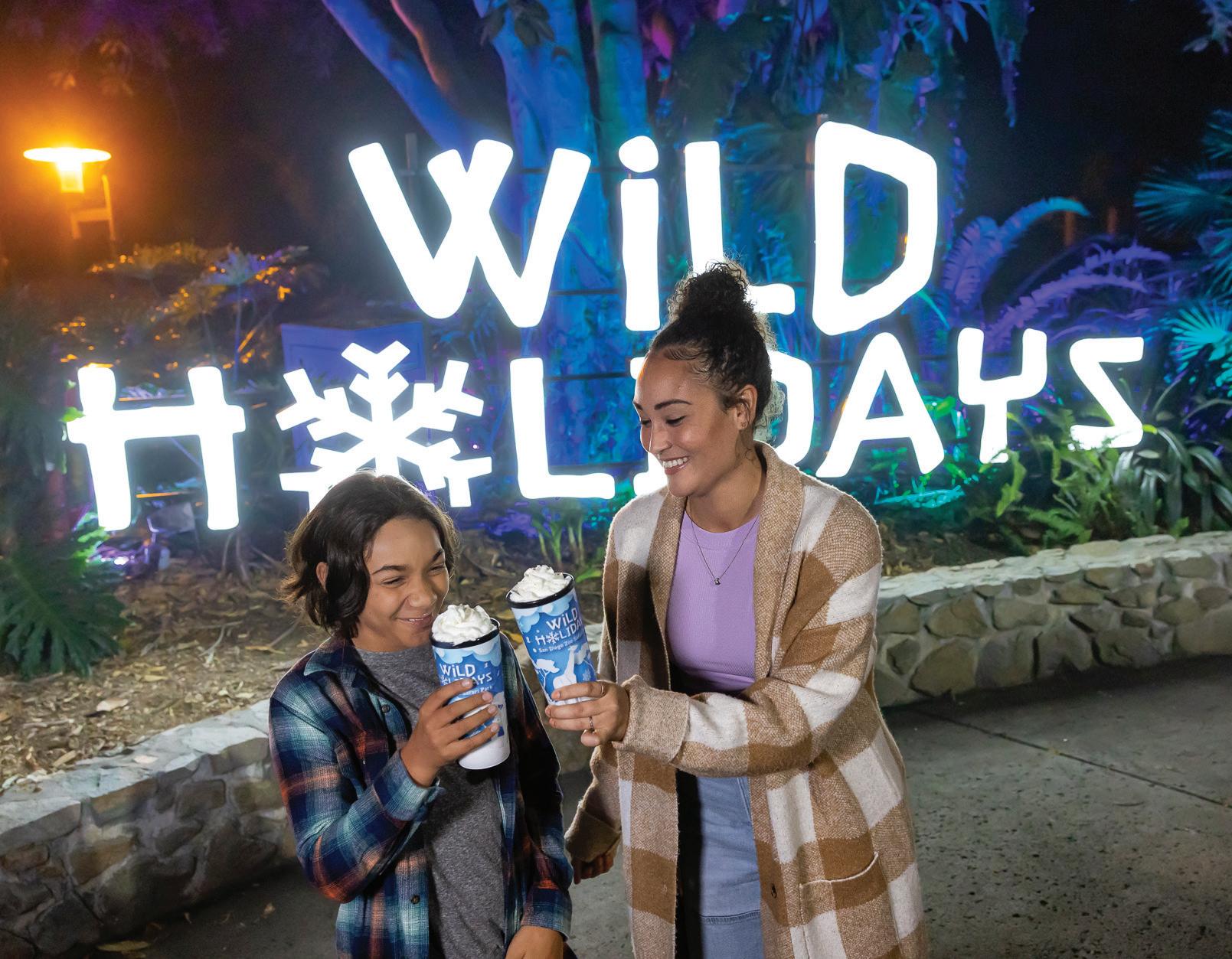
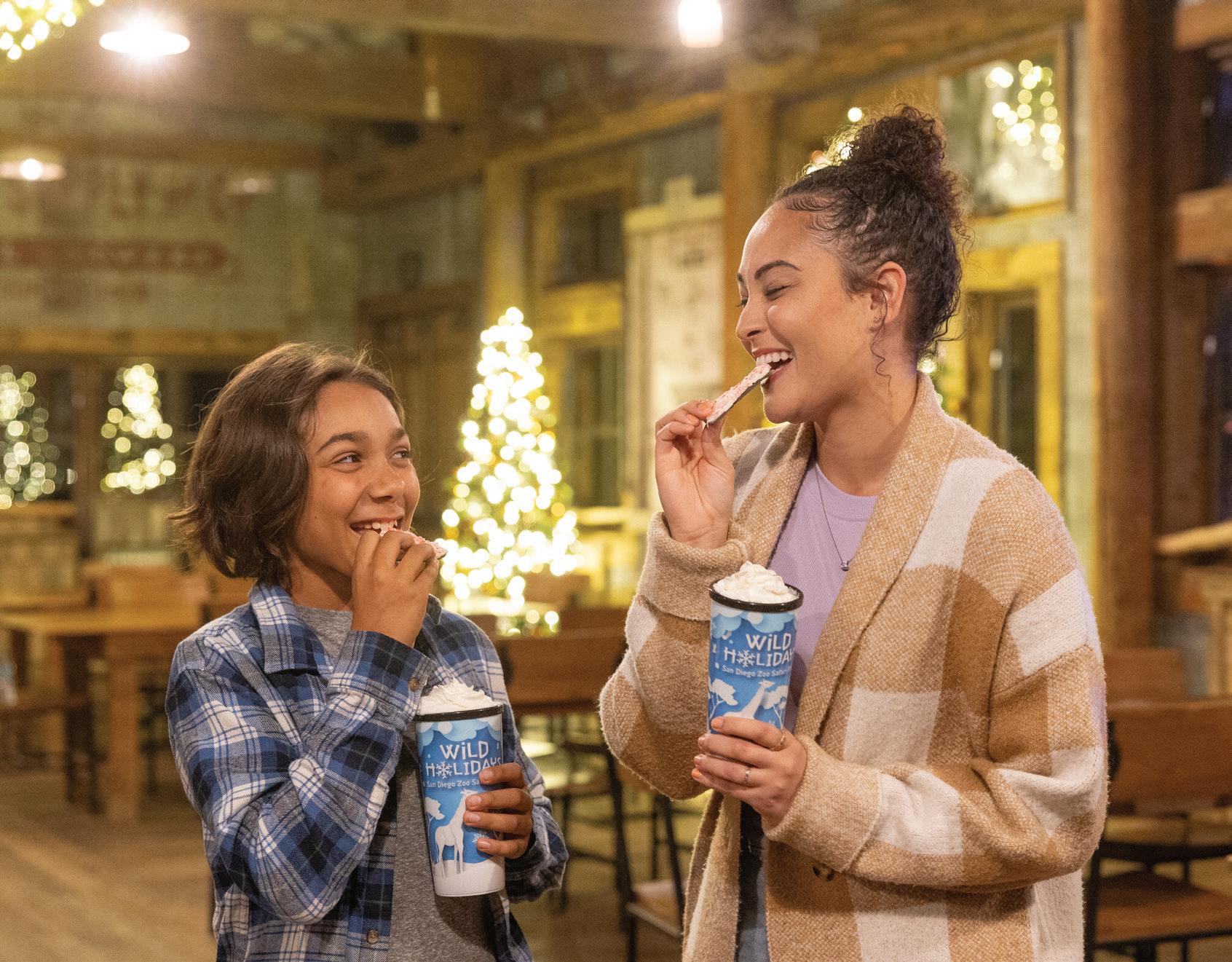
Spend evenings at the Safari Park until 8 p.m., go on a holiday expedition of light, and travel through places that twinkle and glow with holiday cheer. Musical entertainment, storytelling, and culinary treats round out the seasonal festivities.
On November 28, San Diego Zoo Wildlife Alliance members are invited to a Wild Holidays Member Preview. (P)
Botanical Africa Tram Tour at the Safari Park
Find out all about what’s growing on around the Safari Park during a new, flora-focused adventure. Offered Saturdays and Sundays at noon, join us to explore botanical wonders. Reservations are required and there is limited availability— first come, first served. The Botanical Africa Tram Tour is included with admission: visit any ticket booth at the Safari Park for your complimentary ticket. (P)
NOVEMBER 2 & DECEMBER 7
Member Exclusive Early Hours
Rise and shine with the sights and sounds of the Safari Park. On select days, qualifying members* can enter the Safari Park one hour before the general public. To join us, simply present your qualifying membership card at the main entrance beginning at 8 a.m.
*Excludes memberships with blockout dates. (P)
Wild PerksSM
San Diego Zoo Wildlife Alliance members are eligible for Wild PerksSM Show your membership card each time you make a purchase and save up to 20%, depending on your membership level. Some exclusions apply; for details, visit sdzwa.org/ membership/wild-perks. (P)
For San Diego Zoo and Safari Park operating hours, visit sdzwa.org
sdzwa.org
(619) 231-1515
Programs and dates are subject to change—please check our website for the latest information.
(Z) = San Diego Zoo (P) = Safari Park

You’ll see the San Diego Zoo Safari Park in a whole new light during Wild Holidays, when it transforms into a wildlife winter wonderland that glows, shines, and twinkles with holiday cheer. Musical entertainment, storytelling, and culinary treats create family fun and put everyone in the holiday spirit. Throughout this delightful celebration, the Safari Park stays open until 8 p.m., and there’s so much to see and do. While you’re here exploring it all, see if you can match these elements of an exciting and fun-filled winter adventure at Wild Holidays (in the left column) with the places where you’ll find them (at right).
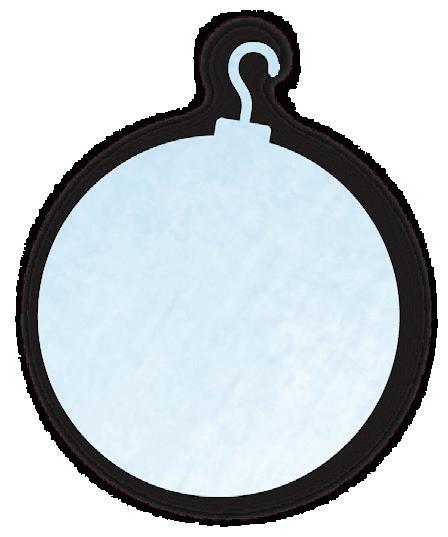






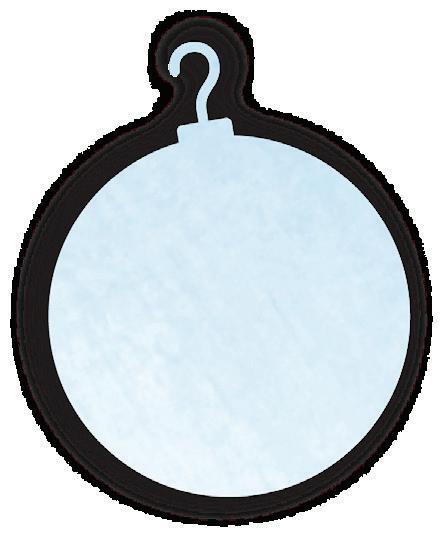



A. Mombasa Lagoon
B. Congo Kitchen
C. Safari Walk Bridge to Condor Ridge
D. Village Playground, Walkabout Australia
E. Safari Base Camp
F. Safari Coffee Outpost, Macan Market, Thorntree Terrace

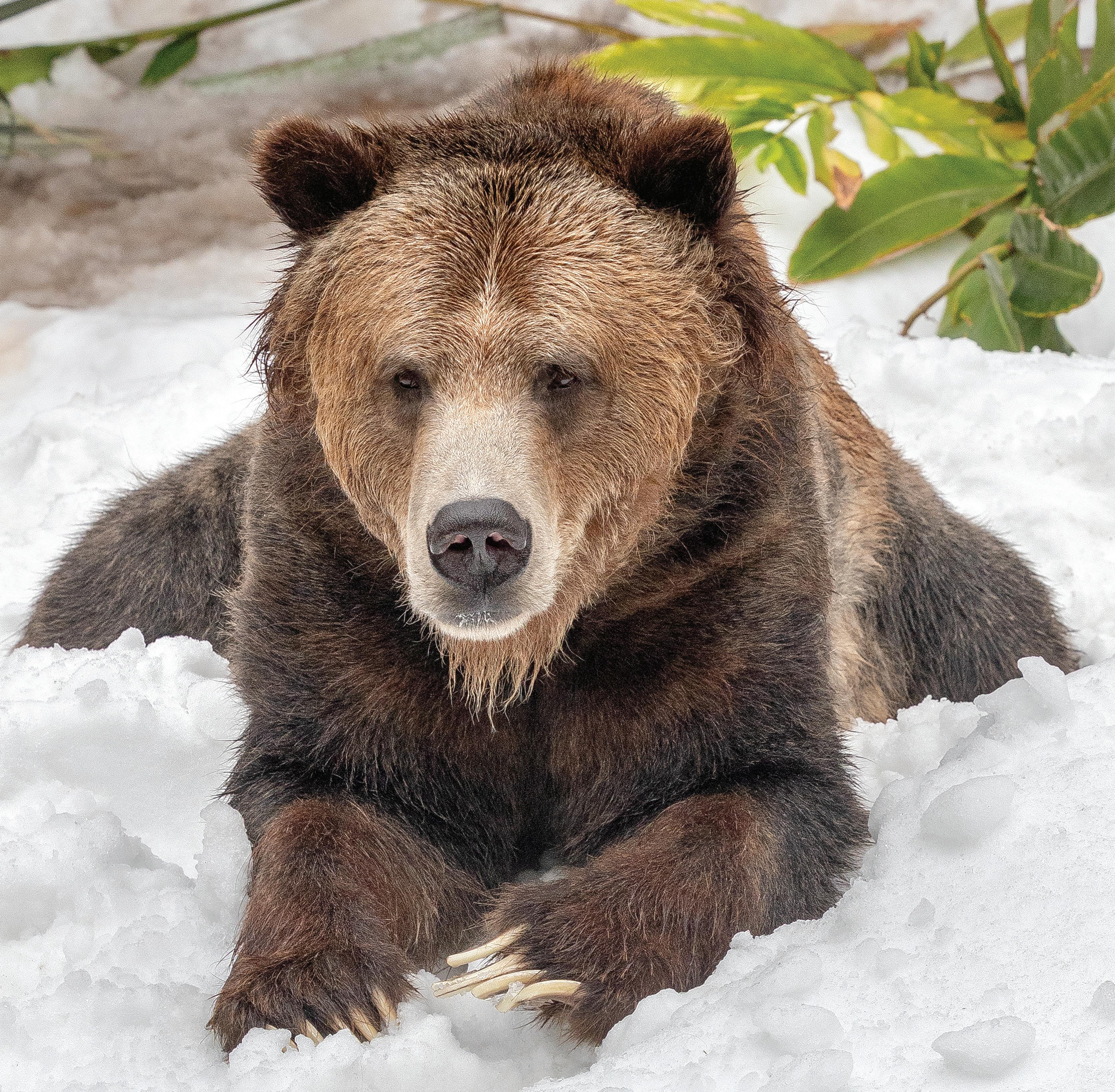
“Beary” cool! Montana the grizzly bear (pictured)—and his sibling Scout—romped, wrestled, and played in the powder during a recent snow day in their habitat at the San Diego Zoo, thoroughly enjoying the sensory experiences of a sudden seasonal snow fall. The 18-year-old brothers have lived at the Zoo since 2007, when they were rescued as cubs.
Photographed by Ken Bohn, SDZWA Photographer
